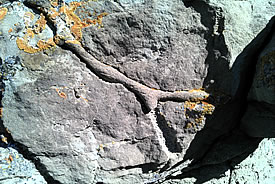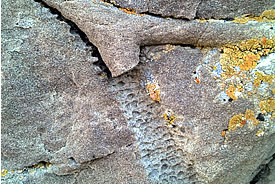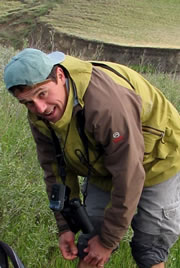Did scientists discover a 70-million-year-old reindeer antler at Sandstone Ranch? The answer may surprise you!

Fossil discovered at Sandstone Ranch (Photo by François Blouin)
Early this fall I and two colleagues travelled 40 kilometres south of Magrath, Alberta to the Sandstone Ranch. MULTISAR had been contracted five years ago to develop a conservation plan for the ranch, which is co-owned and managed by the Nature Conservancy of Canada (NCC), the Alberta Conservation Association, the Alberta Fish and Game Association and the Sandstone Grazing Coop. This fall, we travelled to the site many times to conduct various wildlife surveys to assess progress on the plan.
On this particular day, we were there to conduct a snake hibernaculum survey. South and southwest-facing slopes with rocky outcrops generally offer good potential for snake hibernacula. Snakes congregates at those locations in late summer or early fall to soak in the last of the seasonal heat prior to moving underground through holes and cracks to hibernate below the frost line.

Close-up on Sandstone Ranch fossil (Photo by François Blouin)
So there we were, looking down and around on a coulee slope among the sandstone hoodoos for signs of the reptiles. We were just about done our survey when I looked up on the side of a hoodoo and saw a branch-like carving in the sandstone rock.
At first look, it reminded me of an antler (could it be proof of Rudolph's ancestors having passed by here years ago?), but it was within rock that would have been deposited several million years ago in the Cretaceous era of the Blood Reserve Formation. Then I thought it probably was a plant part (root or branch). It sure looked of biological origin but I have been surprised many times before with similar thoughts just to find out that the feature was of geological source.
Just below the fork a piece had broken and revealed a “pitted” pattern on the rock underneath. This certainly added to my suspicion of a plant as it was reminiscent of bark. The material that made up the feature was not at all different than the substrate in which it was embedded: sand, again indicating that it had been there for as long as the rock itself.
Still unsure what it was that I had seen, I sent the picture to a few geologists for some potential clues as to its identity.
All of my sources returned with the same answer: it is a trace fossil, in this case a burrow, called Ophiomorpha nodosa and made by decapod (10-legged) crustaceans such as the sand shrimp of the genus Callianassa. Thank you to Murray Gingras and George Pemberton at Earth and Atmospheric Science, University of Alberta and to Graham Young from the Manitoba Museum for shedding light on this discovery.
Who would have thought that the Sandstone Ranch was a shoreline with little sand shrimps thriving on it some more than 70 million years ago?


